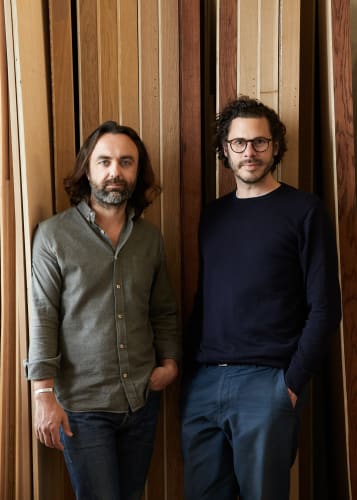GARNIER ET LINKER
Guillaume Garnier and Florent Linker's work is situated at the crossroads of several paths. Rather than defining themselves in a fixed way, they prefer to borrow freely from different disciplines: design, arts and crafts and sculpture. Their work is based on rare materials and skills that they reinterpret in a contemporary way in a collection of lighting, furniture, and objects. They are inspired as much by the decorative arts as by sculpture to create objects with pure forms that reveal the material.
Guillaume Garnier and Florent Linker came away from their years at the Camondo School with the desire to work as closely as possible to the know-how. This is how they embarked on a tour of France, punctuated by visits to workshops, which enabled them to discover a great wealth of techniques. It was by imagining reinterpretations that the first Garnier & Linker lighting collection was born, which was quickly supplemented by pieces of furniture and objects.
The choice of materials such as bronze, plaster or lost wax glass, quickly led to the creation of a workshop where preliminary models, waxes and moulds could be made to go as far as possible in the development of the creations. The successive enlargements of the workshop naturally allowed the integration of most of the production of luminaries and thus to better control the quality of execution. Each model is imagined and developed between the two complementary spaces of the design studio in Paris and the workshop on the edge of the forest of Fontainebleau.
The meeting with Japanese craftsmen is also a key stage in the development of cross-fertilisation between French and Japanese know-how. The collections thus continue to be written along a clear line that is traced according to the meetings and collaborations.
to the meetings and collaborations.
GARNIER & LINKER x DUTKO
The collection designed by Garnier & Linker for the Dutko gallery was imagined as a contemporary re-reading of Art Deco furniture from the beginning of the 20th century, and more particularly that of Eugène Printz, a designer whom Jean-Jacques Dutko has largely contributed to make known. The common point between the different pieces presented is the presence of bronze, which brings a sculptural touch to the more rigorous work of cabinet making, marble or alabaster. Whether it is to form the leg of a coffee table, the hinge of a piece of furniture, the hand grip of a cupboard, or the structure of a table lamp, bronze always plays an essential role.
Each preliminary model, necessary for the realization of the bronzes, was shaped in wax at the workshop of
Garnier & Linker's workshop to give it a shape and texture that brings that characteristic vibration of handmade work.
The creative process developed by Guillaume Garnier and Florent Linker, which borrows from design, craftsmanship and sculpture, is thus reflected.
The encounter between the Dutko Gallery and Garnier & Linker was a natural one, based on a shared taste for Art Deco, particularly its pure forms, and its demand for quality of execution, details and materials. This new collection is thus perfectly in line with the evolution of the Dutko gallery towards contemporary creation, with a nod to its history.

